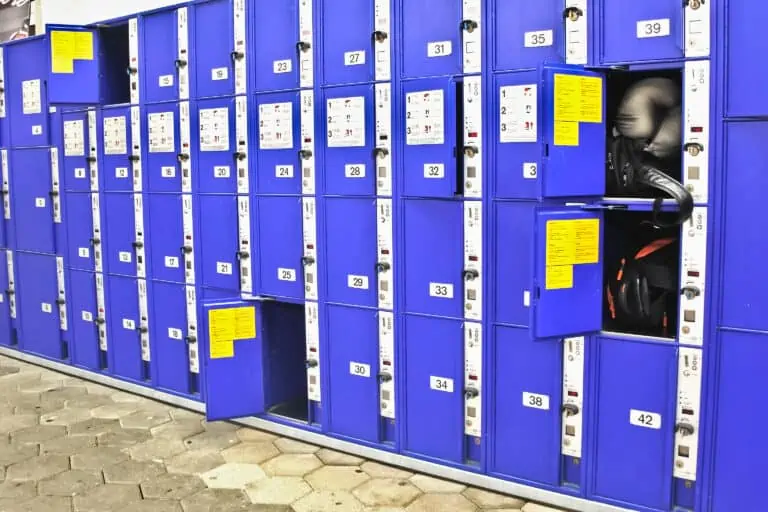How to travel with luggage in Switzerland’s trains
This is how to handle your luggage on Swiss trains:
- Put your luggage in the designated space over the seats, between the backrests, or at the end of the coach.
- Don’t occupy seats with your luggage, especially if it’s busy in the train.
- Keep an eye on your luggage at all times. You’re responsible for it, not the staff or transport company. Theft is not common in Switzerland and it has never happened to Annika and me. But it may occur, mostly at larger crowded stations.
- Use combination locks on your bags’ or suitcases’ zippers. We use them to make quick thefts more challenging, and any attempts less appealing.
If you have more luggage than you can carry, or if you want to travel more comfortably, I recommend looking into a luggage transport service.
Luggage storage at train stations in Switzerland
Can I store my baggage in lockers?
Yes: many Swiss rail stations have lockers. You can access them nearly 24 hours a day. They’re meant for short-term luggage storage for a maximum of 3 days.
What types of lockers are available?
There are 3 types:
- Grey lockers, which can be rented for a minimum payment fee of 6 hours (but you can retrieve your luggage at any time before those 6 hours are over) and a maximum payment fee and rental duration of 96 hours. Payment can be done by credit card, payment apps such as Apple Pay and Samsung Pay, and Swiss coins. You’ll find them at the larger stations, such as Basel, Bern, Geneva, Lucerne, and Zurich.
- Older blue lockers, which can be rented for a minimum payment fee of 24 and a maximum payment fee and rental period of 72 hours. Payment must be made with Swiss coins. The current cash lockers are mostly located at smaller Swiss rail stations. They’re gradually being replaced by other variants though: in the future, none of the Swiss lockers will accept cash anymore.
- Updated blue lockers, which can be rented for a minimum payment fee of 6 hours and a maximum payment fee and rental period of 96 hours. You must pay using your smartphone: either with credit cards such as Visa or Mastercard, or with the payment app Twint which is quite common in Switzerland.
Which lockers are available at my preferred railway station?
The stations at which each locker type is available can be found through these links.
What are the Swiss locker sizes and how much do they cost?
Locker sizes and prices range from:
- S (about 35 cm wide, 45 cm high and 55 cm deep) at CHF 5 to CHF 6 for the first 6 hours and CHF 2 to CHF 3 per additional hour, to
- XXL (about 52 cm wide, 94 cm high and 85 cm deep) at CHF 12 to CHF 15 for the first 6 hours and CHF 6 to CHF 8 per additional hour.
What if I need long-term storage, or if my baggage doesn’t fit in lockers?
Larger Swiss rail stations offer luggage storage at the SBB Travel Centre. This is suitable if your luggage doesn’t fit in lockers, and/or if you want to store it for a period longer than 96 hours.
You can access your luggage during the opening hours of the concerned counters. This is typically between 7-8 am and 6-7 pm.
Costs are CHF 12 per item per day. Each item may weigh no more than 25 kg. Long-term serviced luggage storage is possible too. For example: 1-month storage costs CHF 120 per item.
Luggage transport services
There are various luggage services. Below is an overview of the options. Note that you need to present a valid train ticket or pass when handing in your luggage.
Transport services for trips within Switzerland
The main option, and the one I’d recommend, is the station to station transport service. You can ship luggage from one Swiss rail station to the other. This is available for many, but not all train stations. The price is CHF 12 per item, with a limit of 23 kg per item.
In most cases, you can hand in your luggage before 7 pm and collect it two days later from 9 or 10 am. Timeframes may vary per rail station. Ordering in advance is not required.
Other options:
- Station to door: shipping from a train station to any address in Switzerland or vice versa is possible as well. An additional fee applies. Ordering in advance is not required.
- Door to door: a luggage service from address to address within Switzerland, with an optional express service for same day delivery. This service needs to be booked two days in advance at the latest.
Transport services for international rail journeys and for plane travelers
There are luggage services for train journeys from Germany and Austria to Switzerland and vice versa. If you travel by plane, you can use flight luggage services from and to Zurich Airport and Geneva Airport. Not all airport companies participate, so please check the SBB links here for further details.
Transporting luggage on Postbuses and other buses
There’s room for your luggage in racks and in designated areas of Swiss buses. You can also place bags or smaller suitcases below your seats. In general, there’s less storage space than in trains. If you have more luggage than you can handle yourself, or than you can take along without taking up seats meant for other passengers, it’s better to use a luggage transport service.
If you need a bus ride to reach your hotel, check whether the hotel offers a pick-up service or transfer service for you and your luggage. This is the case for quite some hotels in cities, in larger towns, and near airports.
Transporting luggage on Swiss boats
It’s no problem to bring along backpacks and suitcases on boats. You must be able to handle it yourself though. And it shouldn’t take up space meant for other passengers. That’s why I recommend carrying only relatively small and lightweight items on boats. Leave larger pieces in your accommodation or at the Swiss rail stations’ luggage facilities. Or use one of the transport services.
Please consult the boat companies’ websites for further details. You’ll find links on our boat pages.
Transporting luggage in cable cars and mountain trains
It’s very common to take along light luggage on board Swiss cable cars, cogwheel trains, and funiculars. Examples are backpacks for a day trip, additional hiking gear, skis, and snowboards. If you have larger pieces of luggage, such as suitcases, please check the options in advance. Links to many transport companies can be found on our mountain pages.
How to transport your bike
Transport your bike in Swiss trains
You can take your bike on most trains, provided that its length doesn’t exceed 2 meters and that you can load and unload it yourself. Exceptions:
- In some trains, it’s not possible.
- In some trains, there’s limited space for bicycles.
- Some trains require a reservation. This goes for specific IC (InterCity) trains if you’re traveling between March 21 and October 21 for example.
If there are such limitations, the timetable will show them for your route with a bicycle pictogram. Click on any train of your connection for a legend explaining the symbols. Our timetable guide provides instructions.
If you’d rather have your bike transported, that’s possible too. Most bikes can be shipped with the regular Swiss transport services mentioned above.
As for pricing:
- You need to buy a bike point-to-point ticket. Bike day passes and multiple-day passes are available as well.
- Bikes for children under 6 years old don’t require a bike ticket or day pass.
Transport your bike on Swiss buses
You can transport your bicycle on Swiss buses, but there are limitations. These are the rules:
- You must be able to load and unload the luggage yourself.
- Bikes are allowed on buses in the luggage area, but only if there’s enough space. Wheelchairs and buggies have priority. If there’s no space, you’ll have to wait for the next bus.
- Postbuses operate with bike trailers and bike racks, but only in tourist areas and only from May to October. The capacity varies from 5 to 20 bikes per bus.
- In some cases, you need to make a reservation. This is indicated in the Swiss timetable.
- In some buses, bikes can’t be transported at all. This too is displayed in the Swiss timetable.
Getting your bicycle on other modes of transport
You can mostly bring along your bike on boats and mountain rides. The capacity, rules, and prices differ per transport company. Please check the options in advance. You’ll find links to many companies through our activity pages.
Other websites of interest
- www.sbb.ch: services per rail station: opening hours, lockers plus prices, long-term and large luggage storage, et cetera
- www.sbb.ch: locker types and locations
- www.sbb.ch: FAQ on lockers
- www.sbb.ch: luggage storage at the SBB Travel Centre
- www.sbb.ch: luggage transport services within Switzerland, for groups, and for train journeys from/to Austria and Germany
- www.sbb.ch: flight luggage services
- www.sbb.ch: taking your bike on the train
- www.postauto.ch: traveling with luggage in the Postbus
- www.postauto.ch: taking your bike on the Postbus


